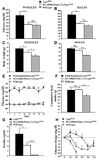Leptin-dependent control of glucose balance and locomotor activity by POMC neurons
- PMID: 19490908
- PMCID: PMC2730605
- DOI: 10.1016/j.cmet.2009.05.003
Leptin-dependent control of glucose balance and locomotor activity by POMC neurons
Abstract
Leptin plays a pivotal role in regulation of energy balance. Via unknown central pathways, leptin also affects peripheral glucose homeostasis and locomotor activity. We hypothesized that, specifically, pro-opiomelanocortin (POMC) neurons mediate those actions. To examine this possibility, we applied Cre-Lox technology to express leptin receptors (ObRb) exclusively in POMC neurons of the morbidly obese, profoundly diabetic, and severely hypoactive leptin receptor-deficient Lepr(db/db) mice. Here, we show that expression of ObRb only in POMC neurons leads to a marked decrease in energy intake and a modest reduction in body weight in Lepr(db/db) mice. Remarkably, blood glucose levels are entirely normalized. This normalization occurs independently of changes in food intake and body weight. In addition, physical activity is greatly increased despite profound obesity. Our results suggest that leptin signaling exclusively in POMC neurons is sufficient to stimulate locomotion and prevent diabetes in the severely hypoactive and hyperglycemic obese Lepr(db/db) mice.
Figures






Similar articles
-
Control of blood pressure, appetite, and glucose by leptin in mice lacking leptin receptors in proopiomelanocortin neurons.Hypertension. 2011 May;57(5):918-26. doi: 10.1161/HYPERTENSIONAHA.110.161349. Epub 2011 Mar 21. Hypertension. 2011. PMID: 21422382 Free PMC article.
-
Direct leptin action on POMC neurons regulates glucose homeostasis and hepatic insulin sensitivity in mice.J Clin Invest. 2012 Mar;122(3):1000-9. doi: 10.1172/JCI59816. Epub 2012 Feb 13. J Clin Invest. 2012. PMID: 22326958 Free PMC article.
-
Conditional expression of Pomc in the Lepr-positive subpopulation of POMC neurons is sufficient for normal energy homeostasis and metabolism.Endocrinology. 2015 Apr;156(4):1292-302. doi: 10.1210/en.2014-1373. Epub 2015 Jan 16. Endocrinology. 2015. PMID: 25594696 Free PMC article.
-
Genetic dissection of neuronal pathways controlling energy homeostasis.Obesity (Silver Spring). 2006 Aug;14 Suppl 5:222S-227S. doi: 10.1038/oby.2006.313. Obesity (Silver Spring). 2006. PMID: 17021371 Review.
-
Central leptin receptor action and resistance in obesity.J Investig Med. 2009 Oct;57(7):789-94. doi: 10.2310/JIM.0b013e3181bb0d49. J Investig Med. 2009. PMID: 20029269 Free PMC article. Review.
Cited by
-
The Role of the Melanocortin System in Metabolic Disease: New Developments and Advances.Neuroendocrinology. 2017;104(4):330-346. doi: 10.1159/000450649. Epub 2016 Oct 11. Neuroendocrinology. 2017. PMID: 27728914 Free PMC article. Review.
-
Effects of the POMC System on Glucose Homeostasis and Potential Therapeutic Targets for Obesity and Diabetes.Diabetes Metab Syndr Obes. 2022 Sep 25;15:2939-2950. doi: 10.2147/DMSO.S380577. eCollection 2022. Diabetes Metab Syndr Obes. 2022. PMID: 36186941 Free PMC article. Review.
-
Leptin revisited: its mechanism of action and potential for treating diabetes.Nat Rev Drug Discov. 2012 Sep;11(9):692-708. doi: 10.1038/nrd3757. Nat Rev Drug Discov. 2012. PMID: 22935803 Free PMC article. Review.
-
POMC neurons expressing leptin receptors coordinate metabolic responses to fasting via suppression of leptin levels.Elife. 2018 Mar 12;7:e33710. doi: 10.7554/eLife.33710. Elife. 2018. PMID: 29528284 Free PMC article.
-
Food intake reductions and increases in energetic responses by hindbrain leptin and melanotan II are enhanced in mice with POMC-specific PTP1B deficiency.Am J Physiol Endocrinol Metab. 2012 Sep 1;303(5):E644-51. doi: 10.1152/ajpendo.00009.2012. Epub 2012 Jul 3. Am J Physiol Endocrinol Metab. 2012. PMID: 22761160 Free PMC article.
References
-
- Baetens D, Stefan Y, Ravazzola M, Malaisse-Lagae F, Coleman DL, Orci L. Alteration of islet cell populations in spontaneously diabetic mice. Diabetes. 1978;27:1–7. - PubMed
-
- Balthasar N, Coppari R, McMinn J, Liu SM, Lee CE, Tang V, Kenny CD, McGovern RA, Chua SC, Jr, Elmquist JK, Lowell BB. Leptin receptor signaling in POMC neurons is required for normal body weight homeostasis. Neuron. 2004;42:983–991. - PubMed
-
- Brito MN, Brito NA, Baro DJ, Song CK, Bartness TJ. Differential activation of the sympathetic innervation of adipose tissues by melanocortin receptor stimulation. Endocrinology. 2007;148:5339–5347. - PubMed
-
- Chen H, Charlat O, Tartaglia LA, Woolf EA, Weng X, Ellis SJ, Lakey ND, Culpepper J, Moore KJ, Breitbart RE. Evidence that the diabetes gene encodes the leptin receptor: identification of a mutation in the leptin receptor gene in db/db mice. Cell. 1996;84:491–495. - PubMed
-
- Coleman DL. Obese and diabetes: two mutant genes causing diabetes-obesity syndromes in mice. Diabetologia. 1978;14:141–148. - PubMed
Publication types
MeSH terms
Substances
Grants and funding
LinkOut - more resources
Full Text Sources
Other Literature Sources
Medical
Molecular Biology Databases
Miscellaneous

